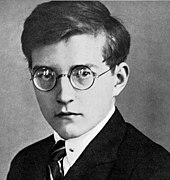Dmitri Shostakovich, born in 1906 in St. Petersburg, Russia, emerged as one of the 20th century’s most influential and controversial composers. His life and work were inextricably linked to the tumultuous history of the Soviet Union, a relationship that both inspired and constrained his artistic expression.
From an early age, Shostakovich displayed prodigious musical talent. He entered the Petrograd Conservatory at 13, where his unique voice quickly became apparent. His graduation piece, the First Symphony, premiered in 1926 to international acclaim, catapulting the young composer to fame. This early success set the stage for a career marked by incredible highs and perilous lows.
Shostakovich’s relationship with the Soviet regime was complex and often fraught with danger. His opera “Lady Macbeth of Mtsensk” (1934) initially received praise but later drew the ire of Joseph Stalin himself. An infamous 1936 Pravda article, likely approved by Stalin, denounced the work as “muddle instead of music,” plunging Shostakovich into a period of intense fear and uncertainty. Many of his friends and family were arrested or executed during the Great Purge, and Shostakovich himself lived in constant fear of arrest.
Despite these pressures, or perhaps because of them, Shostakovich continued to compose prolifically. His Fifth Symphony (1937) was presented as a response to “just criticism,” striking a delicate balance between artistic integrity and political necessity. This work, with its outwardly triumphant finale masking deeper layers of tragedy and irony, exemplified Shostakovich’s ability to speak to audiences on multiple levels.
Throughout World War II, Shostakovich remained in Leningrad during the Nazi siege, composing his Seventh Symphony as a symbol of resistance. This work, known as the “Leningrad Symphony,” became a powerful propaganda tool for the Soviet war effort and solidified Shostakovich’s international reputation.
The post-war years brought renewed political pressure. In 1948, Shostakovich, along with other prominent composers, was denounced for “formalist tendencies” in their music. He responded by outwardly conforming, producing works that satisfied official demands while privately composing more personal pieces, such as the autobiographical Eighth String Quartet (1960).
Shostakovich’s musical style is characterized by its emotional intensity, sardonic wit, and innovative use of traditional forms. His 15 symphonies span his entire career, each a unique reflection of its time. His string quartets, particularly the later ones, are considered some of the most profound works in the genre. He also composed operas, concertos, film scores, and numerous other works across various genres.
Beyond his compositions, Shostakovich’s influence extended to his teaching and mentorship of younger composers. He served as a professor at the Leningrad Conservatory and later at the Moscow Conservatory, shaping the next generation of Soviet musicians.
In his later years, Shostakovich’s health declined, but his creative output continued. Works like the haunting Fourteenth Symphony (1969) and the introspective Fifteenth Symphony (1971) showcase a composer grappling with mortality and reflecting on a life lived under constant scrutiny.
Shostakovich passed away in 1975, leaving behind a complex legacy. His music continues to be performed and debated worldwide, with scholars and musicians still uncovering new layers of meaning in his works. The question of how to interpret Shostakovich’s music in light of his political circumstances remains a subject of intense discussion.
Dmitri Shostakovich’s life and work embody the struggles of artists under totalitarian regimes. His ability to create profound, emotionally resonant music while navigating the dangerous waters of Soviet cultural politics is a testament to his genius and resilience. Today, he is remembered not just as a great composer, but as a symbol of the enduring power of art in the face of oppression.


